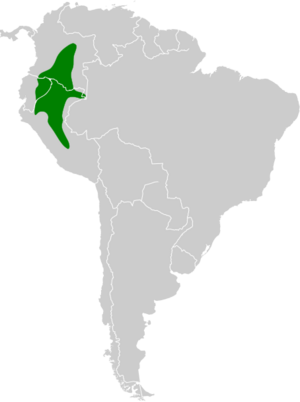Black-throated hermit facts for kids
Quick facts for kids Black-throated hermit |
|
|---|---|
 |
|
| Conservation status | |
| Scientific classification | |
| Genus: |
Phaethornis
|
| Species: |
atrimentalis
|
 |
|
The black-throated hermit (Phaethornis atrimentalis) is a tiny, fast-flying hummingbird. It lives in the warm, green forests of Colombia, Ecuador, and Peru. This amazing bird is known for its quick movements and beautiful colors.
Contents
What Kind of Bird Is It?
Scientists classify animals to understand how they are related. For a while, the black-throated hermit was thought to be a type of little hermit hummingbird. However, experts now know it is more closely related to the reddish hermit and grey-chinned hermit.
Subspecies of the Black-throated Hermit
This hummingbird has two main types, called subspecies. They are the P. a. atrimentalis and P. a. riojae. These are slightly different versions of the same species.
What Does the Black-throated Hermit Look Like?
The black-throated hermit is a small bird, usually about 9 to 10 centimeters (3.5 to 4 inches) long. The P. a. riojae subspecies is a bit larger than the other one.
Colors and Markings
This hummingbird has greenish feathers on its back and head. Its lower back, called the rump, is reddish. Its tail is dark with a white tip. The throat is a dark brown color. The rest of its belly is a reddish-cinnamon color, except for white feathers under its tail.
Differences Between Males and Females
Male black-throated hermits often have a dark band between their throat and chest. Female birds look similar to males, but their throats are usually lighter. Females also tend to have slightly longer wings.
Where Does the Black-throated Hermit Live?
The main subspecies, P. a. atrimentalis, lives in the eastern Andes mountains. You can find it in Colombia, Ecuador, and the Loreto department of northern Peru. The P. a. riojae subspecies lives further south in central Peru. It is found between the San Martín and Pasco departments.
Favorite Places to Live
These hummingbirds prefer to live in the lower parts of rainforests, especially near the edges. They also live in forests that are growing back after being cut down, called secondary forests. You might also spot them in more open areas like plantations or swampy forests. While they mostly live in lowlands, they can be found as high as 1,500 meters (about 4,900 feet) south of Peru's Marañón River.
How Does the Black-throated Hermit Behave?
Staying in One Place
Scientists believe the black-throated hermit does not travel far. It is thought to be a sedentary bird, meaning it stays in the same area all year.
What Does It Eat?
Like many other hermit hummingbirds, the black-throated hermit is a "trap-line" feeder. This means it flies a regular route, visiting many different flowering plants to drink their nectar. It also eats small arthropods, which are tiny creatures like insects or spiders.
When Do They Have Babies?
Not much is known about when black-throated hermits breed. However, observations suggest they may breed in July and November in Peru. In Ecuador, they seem to breed in September.
What Does Its Song Sound Like?
The black-throated hermit has a unique song. It is a high-pitched sound that the bird repeats over and over without stopping. It sounds like "tsee ... tsee ... tsee ... tsee .. tseeetew." When it flies, it often makes a high-pitched "pseep!" call.
What Is Its Conservation Status?
The IUCN (International Union for Conservation of Nature) has evaluated the black-throated hermit. They have listed it as a species of "Least Concern." This means it is not currently considered to be in danger of extinction. However, its total population size is not known, and experts believe the number of these birds is decreasing. Luckily, the black-throated hermit lives in a few protected areas, which helps keep them safe.


